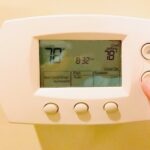Imagine a hidden hero in your home that boosts energy efficiency and keeps temperatures just right. This unsung savior is the attic fan temperature switch. Its smooth operation is vital for maintaining optimal air circulation and saving on energy bills. However, when problems arise, ignoring them can lead to inefficiencies and potential damage. What happens when this crucial component of your home’s system starts to falter?
- Discover how attic fan temperature switches work and why they are integral to maintaining the right attic environment.
- Learn to spot the warning signs of a malfunctioning switch to prevent bigger issues down the line.
- Access a step-by-step troubleshooting guide for diagnosing and fixing common problems effectively.
- Understand when it’s time to replace the switch and get tips on choosing the perfect replacement.
By delving into this article, you’ll not only keep your home comfortable and energy-efficient but also extend the life of your attic system. Ready to transform your approach to home maintenance and tackle this vital yet often overlooked issue? Let’s dive in!
Understanding Attic Fan Temperature Switch Issues
Attic fan temperature switches play a pivotal role in regulating the environment within your attic. By activating or deactivating the fan based on the attic’s temperature, these switches help maintain a stable and suitable climate. This is crucial not only for energy efficiency but also for reducing excessive heat and moisture build-up, which can cause damage to the attic structure and the home overall.
Comprehending how these switches operate involves acknowledging their sensitivity to temperature changes. They are designed to trigger the fan when specific temperature thresholds are met, shielding your attic from becoming excessively hot, which often leads to increased air conditioning costs and potential damage to stored items.
Over time, attic fan temperature switches may encounter operational issues. Recognizing common signs of malfunction is essential for timely intervention. When these switches fail, your attic can either become too hot or too cold, undermining the effectiveness of the entire ventilation system. This can lead to situations where energy bills rise without any apparent reason, or worse, the structural integrity of your home is compromised.
Identifying Common Symptoms of Faulty Switches
To address attic fan temperature switch issues effectively, it is necessary to identify common symptoms signifying potential malfunctions. One of the most noticeable signs is irregular fan operation. This could manifest as the fan turning on and off sporadically, even when the attic temperature remains constant.
Another symptom is the fan’s failure to respond to significant temperature fluctuations. If the fan remains idle when the attic temperature exceeds the set threshold, or conversely, continues to run when cooler conditions prevail, it is likely that the temperature switch is faulty.
Audible cues can also be indicative of issues. If the switch emits unusual noises when the fan attempts to start or stop, this could signal an internal failure.
By paying attention to these symptoms early, homeowners can prevent further complications and maintain their attic’s energy efficiency and structural health.
Troubleshooting Attic Fan Temperature Switch Issues
When your attic fan temperature switch is not functioning properly, it can lead to inefficient temperature regulation and even damage to your home. Identifying the source of the problem is the first essential step. Start by checking the power supply to ensure the fan is receiving electricity. Electrically disconnected fans often stem from tripped breakers or blown fuses, so confirm these components are working correctly.
Next, focus on the wiring of the attic fan to ensure all connections are secure and intact. Loose or corroded wires may prevent the switch from accurately sensing temperature changes. If the wires appear damaged, consider consulting a professional to mitigate any safety risks.
After confirming the wiring is intact, test the attic fan temperature switch directly. Adjust the thermostat setting to see if the fan turns on and off in response to temperature changes. If the fan does not react appropriately, there could be an internal fault in the temperature switch.
If your troubleshooting efforts indicate a deeper issue, it may be necessary to contact a certified technician who can conduct further tests and repairs. Addressing these issues as soon as they arise can help maintain the efficiency and longevity of your attic’s ventilation system.
Replacing Faulty Attic Fan Temperature Switches
Replacing a faulty attic fan temperature switch is sometimes unavoidable to ensure optimal performance. Begin by evaluating whether the switch replacement is necessary. If troubleshooting has revealed consistent failures in temperature response or irregular fan operations, it’s time for a new switch.
Before purchasing a replacement, gather key specifications of your current temperature switch, such as the voltage and model number. This information is typically found on the switch itself or in the fan’s user manual. Armed with these details, you can select a switch that is compatible with your attic fan system.
When installing the new switch, safety should be your utmost priority. Disconnect the power supply to the attic fan to prevent any electrical mishaps. Follow the manufacturer’s instructions closely during installation. Correct installation guarantees the switch’s effectiveness and the overall safety of your home.
Once the new temperature switch is in place, test the system by adjusting the thermostat settings. Verify that the fan responds appropriately to temperature changes, ensuring that your new switch functions correctly. A properly functioning temperature switch not only improves home comfort but also promotes energy efficiency.
Preventing Future Attic Fan Temperature Switch Issues
Ensuring the longevity and efficiency of your attic fan and its temperature switch is vital. Regular maintenance can significantly reduce the risk of malfunctions and help maintain optimal operation.
Begin by conducting periodic checks. Inspect the attic fan and its components, paying attention to any signs of wear or damage. It’s crucial to ensure that the temperature switch is clean and free from dust or debris that could hinder its performance.
Another key practice is to verify the settings of your attic fan’s temperature switch regularly. Make sure they align with the desired temperature thresholds to efficiently manage your attic’s climate. Incorrect settings can lead to ineffective operation or unnecessary energy consumption.
Investing in high-quality components can also play a significant role in prevention. When selecting replacements or upgrades, consider using reputable brands known for reliability and durability. High-quality switches are less likely to malfunction and can contribute to better overall performance of the attic fan system.
Finally, scheduling professional inspections every few years can be beneficial. A trained technician can perform a comprehensive evaluation, identify potential issues early, and provide solutions to avoid future problems. This proactive approach helps maintain your attic fan’s efficiency and efficacy over time.
FAQs about Attic Fan Temperature Switch Issues
What is the role of an attic fan temperature switch?
An attic fan temperature switch regulates the fan based on temperature changes in the attic, ensuring it only operates when necessary.
How can I tell if my attic fan temperature switch is faulty?
Signs of a faulty switch include: irregular fan operation, the fan not responding to temperature changes, or the fan running continuously.
What should I do if my attic fan is not turning on?
Check the temperature settings on the switch and ensure the power supply to the fan is active. If the problem persists, the switch may need replacement.
Can I replace the attic fan temperature switch myself?
Yes, replacing a temperature switch can be a DIY task, but ensure you choose an appropriate replacement and follow safe installation practices.
How often should I maintain my attic fan and switch?
Regular maintenance every 6 to 12 months is recommended to check for any issues and to clean the fan and switch components.





